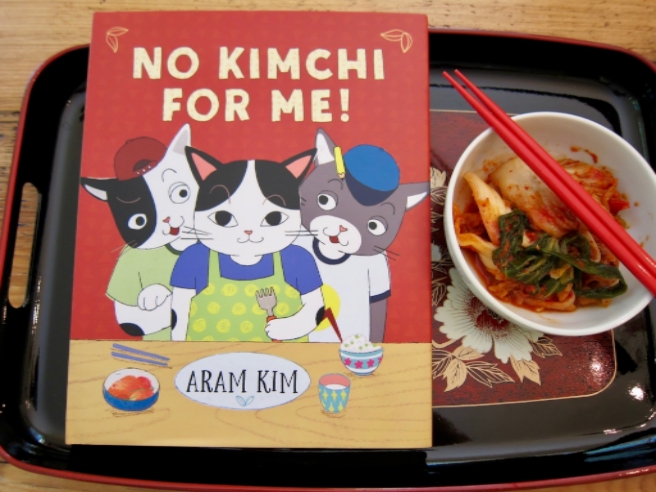
Today I’m pleased and excited to welcome Aram Kim to Alphabet Soup. It’s official release day for her brand new picture book, No Kimchi for Me! (Holiday House)! This mouthwatering story follows on the heels of her heartwarming debut, Cat on the Bus (Holiday House), published in 2016.
I’ve been an Aram Kim fan ever since I first spotted one of her cat bakery illustrations online a couple of years ago. When I visited her website, I instantly fell in love with her pictures of multi-ethnic children and anthropomorphized animals. Her distinctive style exudes a refreshing child-like innocence — emotive, joyful, friendly, accessible, thoroughly charming. Best of all, she likes to draw all kinds of food! A kindred spirit for sure.

When we first connected via email awhile ago, we instantly bonded over our mutual love of food and children’s books, and I was excited to hear she was working on a picture book about kimchi pancakes. Fabulous idea! Since there are very few picture books featuring Korean food, Aram’s book is a rare treat.

In No Kimchi for Me!, Yoomi tries to find a way to eat her grandmother’s kimchi. She likes everything else Grandma makes (“dried seaweed, tiny anchovies, soft egg omelets”), but she draws the line at “stinky, spicy kimchi.”

To make matters worse, her two brothers call her a baby and refuse to play with her because she won’t eat kimchi. Yoomi’s determined to show them she’s definitely NOT a baby, and experiments with different ways of making kimchi more palatable. On a chocolate chip cookie or a slice of pizza? What about hiding it in some ice cream? Well, no.

Luckily Grandma has a plan. Together, they chop, pour, add, and stir the ingredients for . . . a big kimchi pancake! Its delicious aroma lures Yoomi’s brothers right to the kitchen. Will Yoomi like the kimchi pancake and prove that she’s a big girl after all?

It’s a simple story kids will easily relate to, a taste-bud- tempting mix of food, sibling dynamics, and intergenerational love with a Korean twist. Aram’s delightful pencil and pastel illustrations (assembled digitally) are clean and crisp, and packed with so many appealing details.

I love how the story unfolds, the surprises with each page turn. Aram varies picture size and perspective, and alternates double and single page spreads with panels, an engaging way of ensuring each story beat and emotion resonates to maximum effect. And I love the tasty endpapers, showing some of the vegetables used for kimchi, as well as different kimchi varieties (I just learned their actual Korean names).
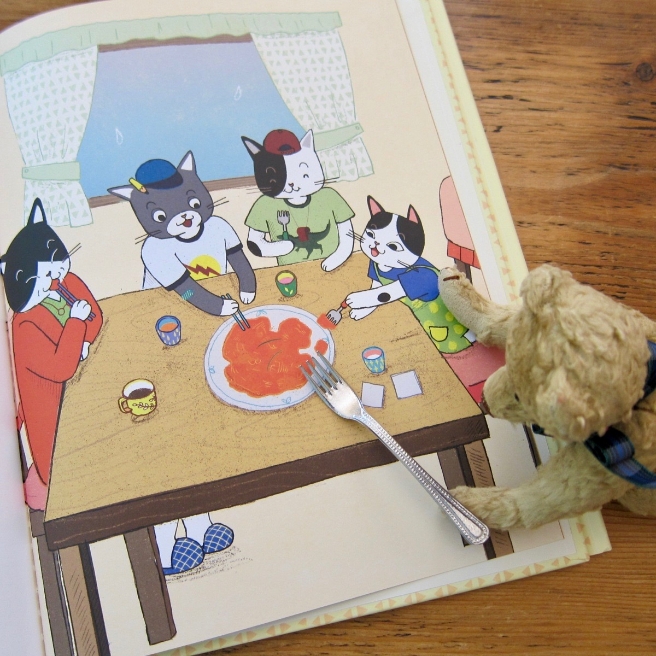
Since your mouth is probably watering by now, let’s find out more of the spicy details from Aram, who’s graciously given me permission to share her mother’s Kimchi Pancake recipe. Enjoy!
*
🍅 KIMCHI CHAT WITH ARAM KIM 🌶

Where did the idea for No Kimchi for Me! come from?
The idea was derived from many different thoughts and experiences, but first, I can’t not talk about kimchi, which is certainly a staple for every Korean meal. My parents lived in U.S. in the late 70s and early 80s. My mom told me that she couldn’t find any napa cabbages at the grocery store, so she made kimchi with regular, round cabbages.
When I moved to New York in 2006 from South Korea, Korean food wasn’t rare, but also not popular. Now, in 2017, anyone can buy a jar of kimchi at Trader Joe’s or Costco. Koreatown in mid-Manhattan used to be all Asians, but now restaurants are crowded with all different races of people and they also buy authentic Korean ingredients at the grocery.
Kimchi was introduced as one of the healthiest foods in the world and became “hip.” As a Korean person living in New York, witnessing this transition has been very interesting, and I have always thought I would do a story about kimchi one day.

Which came first, the story or the pictures? What did you like best about creating this book? What was the most challenging part?
For this book, the story came first — just the idea, not a solid story. After I had a very vague idea of the story, pictures and more detailed stories came hand in hand.
The best part of creating this book was that I felt very at home. There were many parts that I could deeply relate to, loving to eat, not wanting to eat kimchi as a kid, wanting to prove myself as a big kid (I’m the youngest of two), a strong bond with grandma, etc. Also I really love drawing food. I have a blog where I only draw food. So having drawn all this familiar Korean food in a fun story was certainly a blast. Also the expectation that I could be introducing a bit of Korean culture to a wide audience excited me very much.
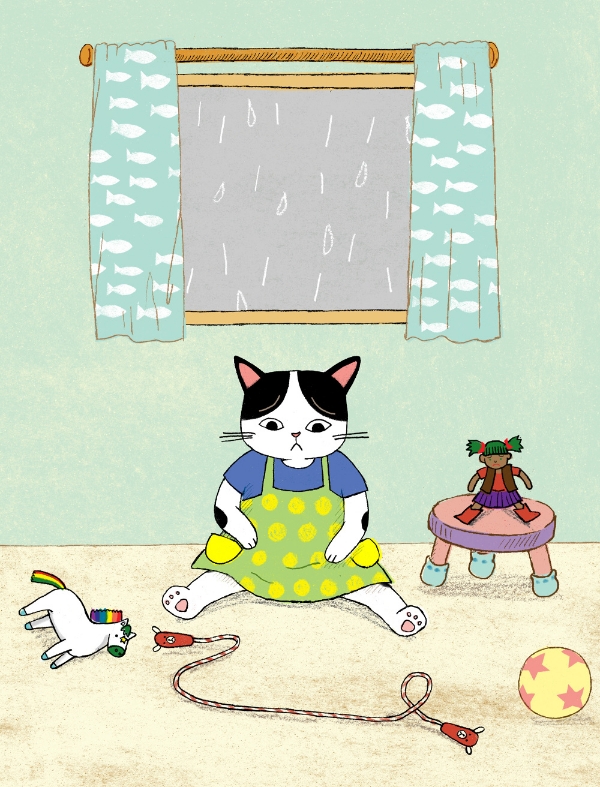
The most challenging part was getting the story right. Like all other stories, this has been revised, evolved, and changed a lot since its very beginning. Over a few years, I brought this story to several conferences and workshops getting feedback and advice. A lot of people helped out with the story and it all has been very helpful!
But at the end, there still was something missing. It was my editor Grace Maccarone who suggested to bring siblings into the story. In my original story, Yoomi was an only child. But by introducing siblings, there came more conflicts and drama, then a flow. It also became more universal as the story contains the usual squabbles and reconciliations among siblings.
Both of your published picture books have cat characters. Do you prefer drawing animals rather than people? If so, why?
I do like drawing animals — a LOT. But I like drawing people, too, so it’s hard to say I prefer one to another. The cat character in the second book was not originally planned. Yoomi was a human girl. But when the book was sold to Holiday House, I was doing some character studies and sent those to my editor asking for her opinion. One of those characters was a cat. It actually wasn’t just for fun. I had an internal debate going on about what the characters should look like.
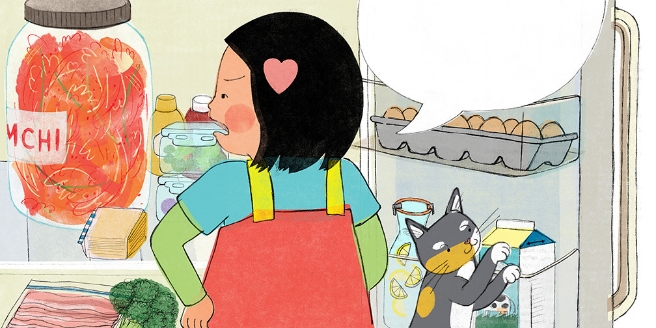

I am very on board with diversity movements in children’s books such as We Need Diverse Books or Multicultural Children’s Book Day (I am in fact creating their 2018 poster). I very much wanted to feature an Asian girl as a main character. But then “kimchi” was so specific and very ethnic; I wondered if characters should be a little more universal so that any child who has not even heard of the word “kimchi” could relate to the book.
If the kid isn’t attracted by the word “kimchi,” she might be attracted by cats. If more kids actually pick up the book, more kids would get a glimpse of a culture and food they might not have known before. That was the idea. Then when the editor responded saying the cat girl was “irresistible,” we decided to go with cat characters.
[Aram’s Character Studies]
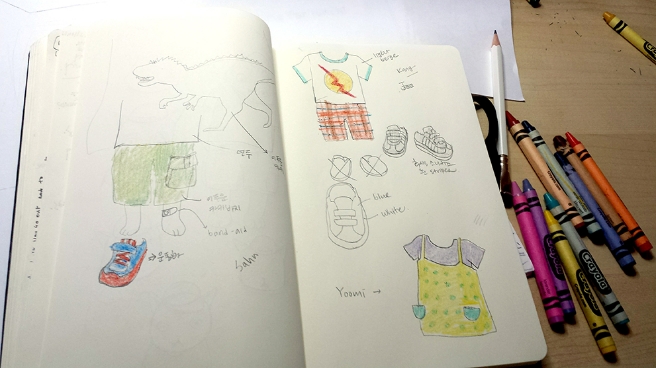
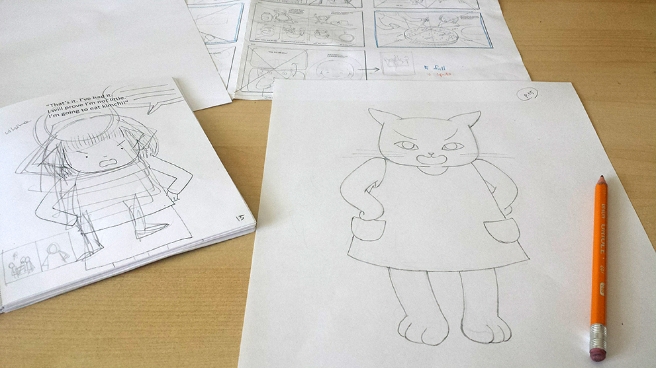

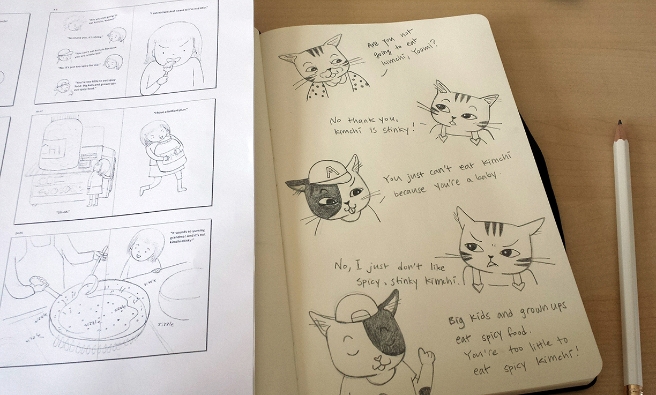

What is your favorite illustration in the book? Could you please tell us, step by step, how you created it?
I think my favorite is the scene where Yoomi and her two brothers are in the attic, each minding their own business, at the beginning of the book. It was very fun to add lots of details and it was a chance for me to sneak in some of my favorite toys from my childhood.

For example, the horse with the star on its forehead is one of my favorite childhood dolls. The teddy bear with the wizard’s hat in the red box is still sitting on my bed. Tiny objects on the bookshelf are souvenirs I’ve gathered over the years.
To make art for this book, I drew with pastels and color pencils on copy paper, then scanned them in to digitally color. So the process goes like this:
1) Once I have a rough sketch, I draw on a copy paper in size. This serves as my guide;
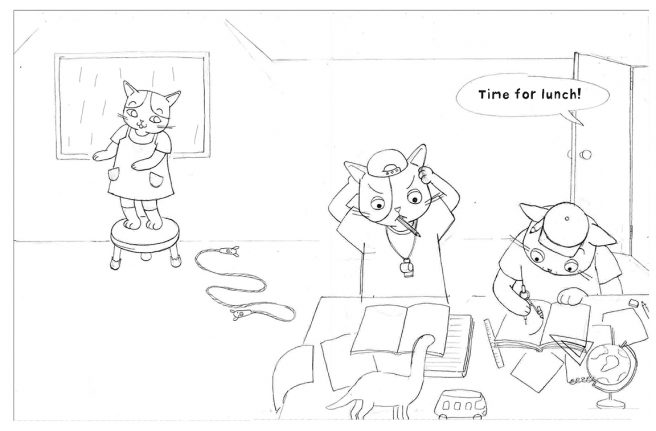
2) Using the guide drawing and a light box, I color isolated shapes with pastel on separate pieces of paper;

3) I scan them into Photoshop, as grey scale;
4) I assemble the parts into a whole black and white drawing as if doing a puzzle;
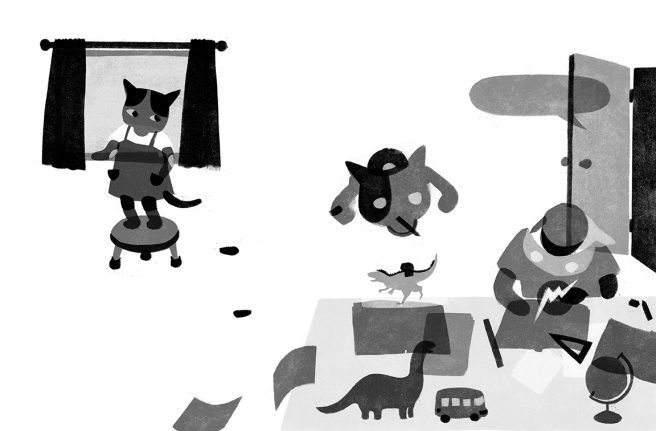
5) Once all pieces fall into the right place, I start coloring the pieces digitally using Photoshop.
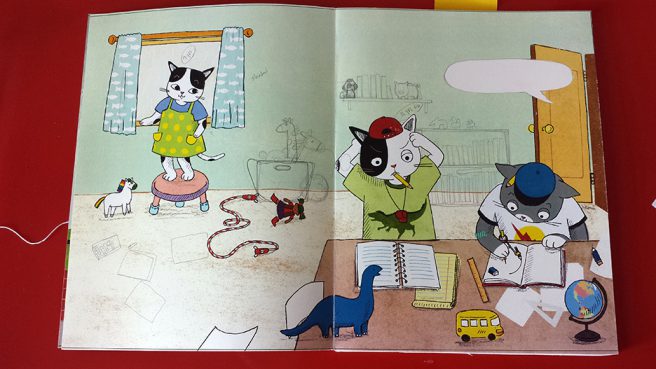


When I finish coloring the entire book, I make a trip to the store where they print in color. I print the entire book and make them into a dummy. That way, I can see what I didn’t see on the computer screen and also I can check the page turn. I add details, spot the inconsistency, revise art, and make notes. I repeat this process until I am happy with the final art. Over the process, I end up making lots of dummies, in various sizes.


Once all pieces fall into the right place, I start coloring the pieces digitally using Photoshop.
Which books and/or authors have had the most influence on your work? What were some of your favorite childhood books?
It seems utterly impossible to name just a few, because there are so many, but I have to mention the impact Maurice Sendak had on me. I did not know who Maurice Sendak was before I came to New York in 2006. I’d just moved to my school dorm from South Korea that summer, was exploring the city, and walked in Barnes & Noble in Union Square.
 I found the children’s book section and was just browsing. I wasn’t particularly focusing on children’s books at that time — I came to New York to study illustration in general. But then this book, In the Night Kitchen, caught my eye. It’s indescribable how I felt at that time — the entire book was so masterfully done, with the art, text, composition, and layout — everything. I was fascinated and totally absorbed. In the Night Kitchen became the first book I bought in the U.S.
I found the children’s book section and was just browsing. I wasn’t particularly focusing on children’s books at that time — I came to New York to study illustration in general. But then this book, In the Night Kitchen, caught my eye. It’s indescribable how I felt at that time — the entire book was so masterfully done, with the art, text, composition, and layout — everything. I was fascinated and totally absorbed. In the Night Kitchen became the first book I bought in the U.S.
Only later I learned that he was a living legend and master of the field. (And to my surprise, I learned that In the Night Kitchen had been very controversial and greatly debated over when it was published!!) Maurice Sendak’s Higglety Pigglety Pop! Or, There Must Be More to Life is my all-time favorite book that I keep buying but keep giving away to friends, so I don’t currently have a copy.

 As far as my favorite childhood books go — it was Charlotte’s Web without a doubt. I’ve always loved books, but Charlotte’s Web was particularly special. I always very clearly remember the illustrations and story. And because of that book, I never once was afraid of spiders in my life! They are all Charlotte’s cousins and friends after all. And also, I have to mention Black Beauty, which is a memoir of a black horse. As a kid, I read it over and over again. I think that might have been the beginning of my interest in animal rights.
As far as my favorite childhood books go — it was Charlotte’s Web without a doubt. I’ve always loved books, but Charlotte’s Web was particularly special. I always very clearly remember the illustrations and story. And because of that book, I never once was afraid of spiders in my life! They are all Charlotte’s cousins and friends after all. And also, I have to mention Black Beauty, which is a memoir of a black horse. As a kid, I read it over and over again. I think that might have been the beginning of my interest in animal rights.
Have you always liked kimchi? What is your favorite kind?
I think a lot of kids in Korea start eating kimchi at a quite young age. But I hadn’t cared for kimchi until I was about 12 because I did not like spicy food in general. But then, as if different taste buds awaken all of a sudden, I started liking kimchi and became the one in the family who would eat it most. Now that I’m in U.S. I don’t eat kimchi very often. I’ve been thinking of making some kimchi on my own for a long time, but I have just never put it into action.
My absolute favorite kind of kimchi is muchae kimchi — made of daikon radish. It looks like this:

It’s pretty similar to kkakduki, which is also made of daikon radish, but while kkakduki is cut into square shapes, muchae is in long, chopped shapes. Crunchy, refreshing, and so delicious! My mom always makes this fresh whenever I go back home to South Korea, and she makes sure it doesn’t run out while I’m there.
Was there a particular food you refused to eat when you were a child, but have gotten to like now?
Tomatoes! When I was a kid, I thought the seeds of tomatoes looked like a yellow caterpillar. Ew. I can’t eat caterpillar, can I!? I very distinctly remember the time when tomato slices were served as a snack in the kindergarten I was attending. I couldn’t eat it. But guess what? There were several other kids who also refused to eat tomatoes! Only the kids who finished their snacks were allowed to go out and play. So we, miserable comrades, were left behind looking down at our plates very gloomily. When the teacher finally gave up on us and let us go, play time was already over! I still remember the disappointment very vividly.
It took awhile until I actually enjoyed them, but now tomato is one of my staples in the fridge! Mmm- so fresh!

Could you please share a favorite childhood food memory?
My favorite memory is probably when my grandmother fed me a soft persimmon with a spoon when I was sick. I think I was about 5 or 6 years old. One morning, I woke up a little feverish. I went to the bathroom and saw I had weird red spots on my face — turned out that I had chicken pox. I stayed in bed all day. I remember I wasn’t suffering much — I was actually enjoying it quite a bit. I wasn’t very sick, but everyone was taking care of me.
My sister would run to the store without complaining when I said I wanted a soda! Then in the afternoon, my grandma came to visit me. She brought soft persimmons and fed them to me with a little spoon — it was so sweet, soft, and melted in my mouth. That memory has stayed with me so warmly, I still crave soft persimmons when I get sick.
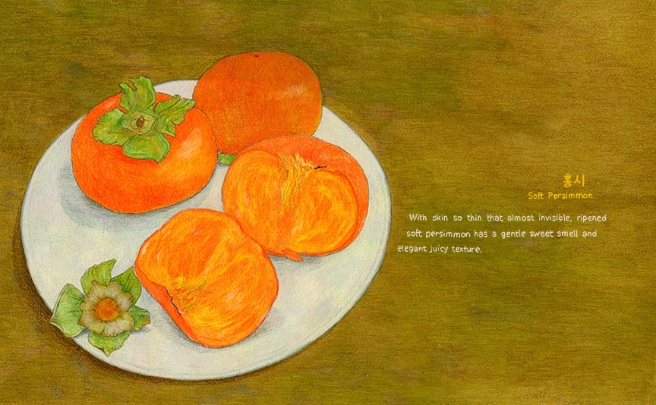
Do you do school visits? If so, what are they like?
I certainly do. It is one of the most exciting and rewarding parts of the job. It is very gratifying to see how children react and respond to my story and pictures. I mostly share my creative process of making the book, using lots of visuals.
I strongly believe every child is a great storyteller in nature however it is manifested. I talk about inspiration and expressions, and encourage children to write and draw by sharing my creative process, from an empty piece of paper to drawing squiggles, to lots of trial and error, and then to the final work. I also introduce my background in South Korea using a world map or globe to show the children the relation between the U.S. and South Korea. It is to explain that “being oneself” helps tell the story.

I also believe even just sharing the fact that there are people who come from other parts of the world, and that one of them is right in front of their eyes, can extend children’s horizons. I usually end the visit with reading one of my books, then answer questions from the children.
Is there anything else you’d like us to know about this book?
After creating all the art inside of the book, it was time to create the endpapers! I love looking at other books’ endpapers — sometimes they are solid colors, sometimes fun patterns, and sometimes an extension of the story. I wanted to do something fun with them. The front and back endpapers are related — the front endpapers feature the vegetables to make several different kinds of kimchi that are featured in the back endpapers. I also asked my mom a lot of questions about her kimchi pancake recipe and her knowledge about different kinds of kimchi while creating this book. She has been a big part of the process!

What are you working on now?
I am working on several different stories! I am in fact waiting to hear back from my editor. I don’t know which will be my third published book, but I am working on a story about the father-daughter bond, a story about how reading is empowering, and a story about finding oneself.
*
🐱 KIMCHI PANCAKE RECIPE 🥘
Aram included her mom’s Kimchi Pancake recipe in the back of the book, so naturally the Alphabet Soup kitchen helpers and I were anxious to try it.
Though I’d eaten kimchi pancakes before, they weren’t something my mother ever made while I was growing up. Perhaps I first tasted them at my grandmother’s house. In any case, this was my first time making my own kimchi pancakes.

The recipe is simple — simply add chopped kimchi to a basic flour, egg, and water batter and fry until crisp. I sliced my pancake into smaller pieces for ease of serving as an appetizer or side dish. They can be eaten plain, dipped in vinegar + soy sauce, or topped with mozzarella!
After reading Aram’s delightful story, kids will be anxious to try making and eating their own kimchi pancakes. Thanks for sharing your recipe, Mrs. Lee!
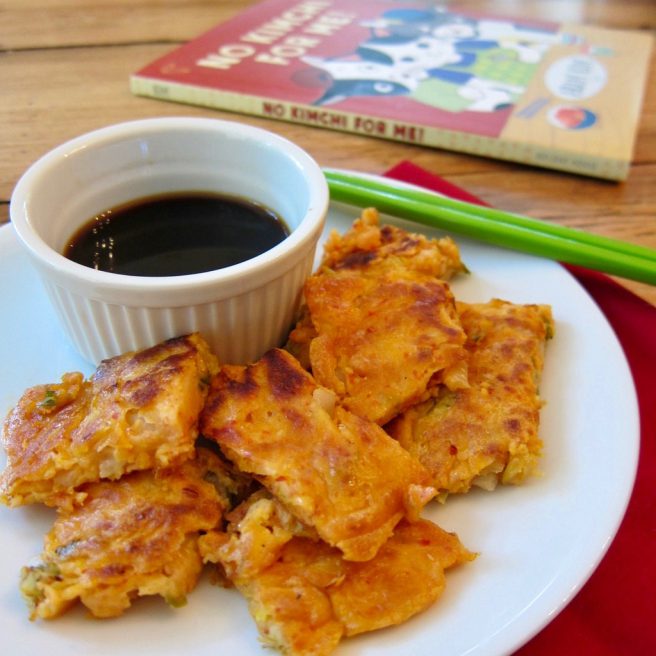
Eunsook Lee's Kimchi Pancakes
Ingredients
- 2 cups chopped kimchi
- 1 cup all-purpose flour
- 1 cup cold water
- 1 teaspoon salt
- 1 teaspoon sugar
- 1 egg
- (optional) 1/2 cup pork or squid, cooked and finely chopped
- (optional) chopped onions
Directions
- Place all the ingredients in a bowl and mix well.
- Grease a large frying pan with a generous amount of oil, and heat over medium high.
- Spread the batter thinly in the pan and cook for 2 minutes.
- When the bottom of the pancake gets golden brown and crispy, turn it over and cook for another 2 minutes.
- Enjoy together with family and friends!
Tips
- Use sour kimchi for kimchi pancakes, not freshly made kimchi.
- If you are using packaged Korean pancake mix, all you need is the mix, kimchi, and water!
- Kimchi pancakes are delicious with mozzarella cheese on top! Yum.
~ from No Kimchi for Me! by Aram Kim (Holiday House, 2017), as posted at Jama’s Alphabet Soup.
*

NO KIMCHI FOR ME!
written and illustrated by Aram Kim
published by Holiday House, September 5, 2017
Picture Book for ages 3-7, 40 pp.
*Includes Kimchi Pancake recipe
**A Junior Library Guild Selection
♥ Visit Aram Kim’s Official Website and yummy blog, Illustrated Memory
♥ Click here for a Kimchi Pancakes Activity Kit!
♥ Enjoy this wonderful KidLit TV video of Aram reading the book.
*
📕 SPECIAL BOOK GIVEAWAY! 📘
The publisher is generously providing a copy of No Kimchi for Me! for one lucky Alphabet Soup reader. For a chance to win, please leave a comment at this post no later than midnight (EDT) Tuesday, September 12, 2017. You may also enter by sending an email with “KIMCHI” in the subject line to: readermail (at) jamakimrattigan (dot) com. Giveaway open to U.S. residents only, please. Good Luck!
*
🎉 CONGRATULATIONS, ARAM. HAPPY BOOK BIRTHDAY! 🎂
*Interior spreads posted by permission of the author/illustrator, text and illustrations copyright © 2017 Aram Kim, published by Holiday House. All rights reserved.
**Copyright Jama Rattigan of Jama’s Alphabet Soup. All rights reserved.

Oh, my gosh, Jama, I LOVE, LOVE, LOVE how you put this together – thank you so much!!! And you brought back cat bakery header!!! ❤ ❤ ❤
LikeLiked by 1 person
Glad you like the post, Aram! Of course I had to bring back the famous Cat Bakery header. One of my all time favorites. 🙂
LikeLiked by 1 person
YUM! I love kimchi and now I need to make kimchi pancakes! (Okay, truth – I need to make Bob make me kimchi pancakes)! I’d love a copy of this book! Adorable! Congratulations to Aram Kim!
LikeLiked by 1 person
Does Bob like kimchi too? He could whip these up in no time.
LikeLike
My sister is Korean (we’re all adopted) and she loves kimchi! So do other members of our family, but not me. Maybe I would like kimchi pancakes!
LikeLiked by 1 person
Oh, you’re just like Yoomi . . . perhaps kimchi pancakes will make you a convert. 🙂
LikeLike
I’ve eaten kimchi with my Korean niece who really doesn’t like it very much, too spicy just like Yoomi! But I did. I’ve never thought of eating it in a pancake. What a rich post, Jama. There are so many things I enjoyed reading, especially about the long process of creating this wonderful picture books. It looks delightful, and I admire the persistence to produce it. I also liked hearing Aram’s knowledge of how things have changed about food through the years & her reasons for changing the character from human to cat. Thanks Aram for your beautiful book, and Jama for the terrific post!
LikeLiked by 2 people
Yes, I found that part interesting too, when Aram talked about how food culture has changed in NYC. Of course it’s always great to hear about the writing/illustration process. I do remember seeing Aram’s human Yoomi years ago — had no idea she would change the main character to a cat. I think it was a good decision and for reasons she mentioned, will widen the appeal of this story.
Regarding your niece — maybe she could try some milder kimchi. Both my grandmothers made kimchi — one made it pretty hot and spicy, the other mild yet still flavorful. Maybe turning down the heat a little will make it more palatable for her . . . unless she can be converted via kimchi pancakes! 🙂
LikeLike
Congrats, Aram! I love your art and enjoy following you on Instagram. Happy Book Birthday & welcome back to blogging after your summer break, Jama 🙂
LikeLiked by 1 person
Aram’s art makes me happy — the childlike joy is unmistakable. Thanks for the welcome back, Maria!
LikeLike
This book is adorable and I loved learning all about Aram Kim’s process in creating it. So interesting to see her original sketches and how Yoomi went from a human character to a cat. I’m impressed with how many dummies and variations she works through, as well. Thanks for sharing this, Jama, and for the recipe. I don’t think I’ve ever tried kimchi, but these pancakes looks delicious!
LikeLiked by 1 person
You need to try kimchi sometime, Marcia — will clear your sinuses at the very least. 🙂
LikeLiked by 1 person
I just love this story by Aram, and her illustrations are so fantastic. What a treat to see her process! 🙂 We are (kinda) neighbors, and I had seen her talk a little about the book a couple of weeks ago. I love reading more about the back story here! As always, you’ve put together such a delightful post, Jama! And that kimchi pancake from the book you made looks so delish!
LikeLiked by 1 person
So many talented, creative people living in your neck of the woods, Melissa. Am not surprised you’ve run into Aram.
LikeLike
Looks like a wonderful book! Hope I can win a copy, but will be on the look-out to get it some other way if I don’t win. I love this storyline and this artwork — and I love kimchi!
LikeLiked by 1 person
Yay, a kimchi lover! Good luck with the giveaway. 🙂
LikeLike
Ooh, this is cute – and also making me curious about what I could do with a kimchi pancake! A friend introduced me to kimchi pizza she and her sister love… and now I’m pretty convinced there’s NOTHING you can’t pair with kimchi! Adding a cute kitten just makes it even better.
LikeLiked by 1 person
I’ve heard of kimchi pizza but haven’t tried it yet. I don’t think I’d take to kimchi with ice cream, but I do like putting a few strips of kimchi in a tuna sandwich now and again.
LikeLike
Happy book birthday to No Kimchi for Me!
LikeLiked by 1 person
Thanks for commenting, Michelle!
LikeLike
Thank you to Aram Kim for sharing her creative process with us. Thank you to Jama Rattigan for writing her blog and for featuring interviews with such “delicious” author/illustrators. I am now motivated to reading your book and making kimchi pancakes!
LikeLiked by 2 people
I hope you try making kimchi pancakes, Laurie.
LikeLike
LOVE!
LikeLiked by 1 person
Thanks for visiting! Glad you enjoyed reading about Aram’s new book. 🙂
LikeLike
What fun and beautiful work!
LikeLiked by 1 person
Cat’s meow! :
LikeLiked by 1 person
What an awesome post! Aram is not only talented…she is super sweet and a blast to work with on projects. I will always be a fan of her work 🙂
LikeLiked by 1 person
I’m a lifelong fan too! Glad you enjoyed the post. 🙂
LikeLike
“No Kimchee for Me” is a delightful idea and the book looks wonderful. I love the idea that the kimchee itself is specific enough about the origin of this food, so the character can be a cat — not a specifically ethnic human. So perfect!
“Miss Kim” a relatively new restaurant in our town (Ann Arbor, MI) makes several types of kimchee, along with lots of Asian fusion food. Your post will make me more aware of the variety in this dish.
best… mae at maefood.blogspot.com
LikeLike
I was surprised at how many varieties of kimchi I hadn’t tried before, thanks to Aram’s endpapers. Kimchi = Korean food, just like sushi = Japanese food.
LikeLike
What a wonderful post. I enjoyed hearing about the story, seeing the illustrations for the book, the life of the author ,and of course the recipe. Personally, I have difficulty eating hot pepper which in in kimchi-I know it is so good for you, I wish I could eat it. I’m inspired to try the pancake for my family.
LikeLike
You’re just like Yoomi — it’s best to start with a milder form of kimchi if you can’t eat the really hot and spicy kind.
LikeLike
What a super story and I adore the illustrations. I also loved learning more about Aram. I fell in love with kimchi when I lived in Hawaii in the late 1970s and was sorry I couldn’t get it on the mainland. But, now, of course, it’s almost mainstream! I’ve never had it in pancakes, so I must give that a try.
LikeLike
It took awhile for it to become mainstream. I guess I find that surprising since I grew up with it in Hawaii.
LikeLike
I am now resolved to try kimchi. Thanks
LikeLiked by 1 person
the illustrations are simply wonderful as is the story too. I would love to have this book on my shelf.
LikeLiked by 1 person
This looks like such a fun book and great review and interview. I am a fan of kimchi and have made several different dishes with it as well–but never pancakes so I must give them a try! 😉
LikeLike